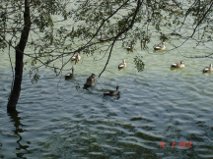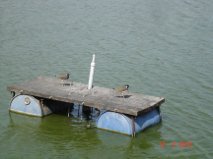Bird Watching
Birding Expedition at Hauz Khas Lake
-Prya Phadtare
One rarely manages spot birds in a big bustling city like New Delhi. To satiate my needs of bird-watching I decided to take along my camera and scourge the city for some rarely spotted birds. Hauz Khas happened to be my obvious choice which is situated in the
metropolis of South Delhi, built during the rule of the Delhi Sultanate. The complex offers excellent wildlife and bird viewing, which is a rarity in the city.
One needs to walk through the Deer Park, known for its large population of deer, in order to get to the lake. As I walked through the park I could smell the distinctive smell of the lake water and hear the quacking of the ducks, yes ducks! This made me hurry
up my walk towards it.
As I entered the arena which houses the lake and the ruins of the Sultanate period I was welcomed by cool breeze, bright sunlight and constant quacking of the ducks. I was dumbfounded to spot at least a congregation of two hundred ducks and along with them
a lot of white geese. I immediately checked my Bird-Watchers Handbook to be able to name them exactly.
I keenly observed a group of ducks quacking happily while trying to catch hold of the tadpoles which had gathered around the edge of the lake under the shade of a tree. I noticed that the grey ducks had a distinctive patch of blue and green inside their wings.
This helped me recognized them as the Indian Spot-Billed Duck. Its scientific name is Anas poecilorhyncha which is native to tropical and eastern Asia. The duck is mostly found in the southern part of the country but it travels a little northward in the winters
as part of its local migration routine. The ducks are medium built with a grey plumage and have brightly yellow coloured bill tips.

I could immediately relate them to a character called Karoo in Japanese manga which is supposed to be the ‘Super-Spot Billed-Duck’.
I walked a little further ahead along the edge of the lake to find white geese! The Snow Geese looked majestice against the backdrop of sparkling water and the black branches of the long dead trees rising out of the water. Some of them decided to come out of
the water to eat the grains kept out for them, that’s when I got the opportunity to get closer to them. The snow geese happen to have two colour plumage morphs, Hauz Khas had the white ones. They are mostly found in the marshy areas and lakes and are not
migratory in nature. Their nesting period is in the months of monsoon. My handbook said that they are loud enough to be heard from a mile away!

The Hauz Khas Complex is known to be famous for only its ducks and geese as one often ends up missing out on other bird species like the Red Wattled Lapwing and the Kites. No matter the season or how many times you visit, you will always be able to find exciting
new mixes of different bird species, so rest assured that even the most insatiable bird watcher will be satisfied.
I happened to chance upon a beautiful sighting of the Red Wattled Lapwing. Two of those were very majestically perched upon a raft. My handbook gave the scientific name of the birds, which is Vanellus indicus, and said that they are famous for their loud alarming
calls which are mostly interpreted as someone saying did he do it or pity to do it earning them a colloquial name of the did-he-do-it birds. The bird has a distinctive trail of black running from its chest to the sides of its crown with its wings being brown
and the eyes lined by red. The Lapwings breed in the months of March to August and are infamous for nesting in between the stones of the railway tracks, otherwise they prefer nesting on the trees and live around large open water bodies.

Apart from the birds mentioned above I saw many kites soaring in the sky, unfortunately I couldn’t get close enough to get a good picture to be able to recognize them.
The Hauz Khas Complex promises you many adventures and a lake full of ducks, geese and a lot more. Don’t be shy from entering the ruins as the view offers a grand a picture of the several bird species hopping or swimming from point to the other point of the
lake while you read your favourite book. It is a great place to pull out your binoculars, scope and get mesmerized on your walk along the bank of the lake!
|